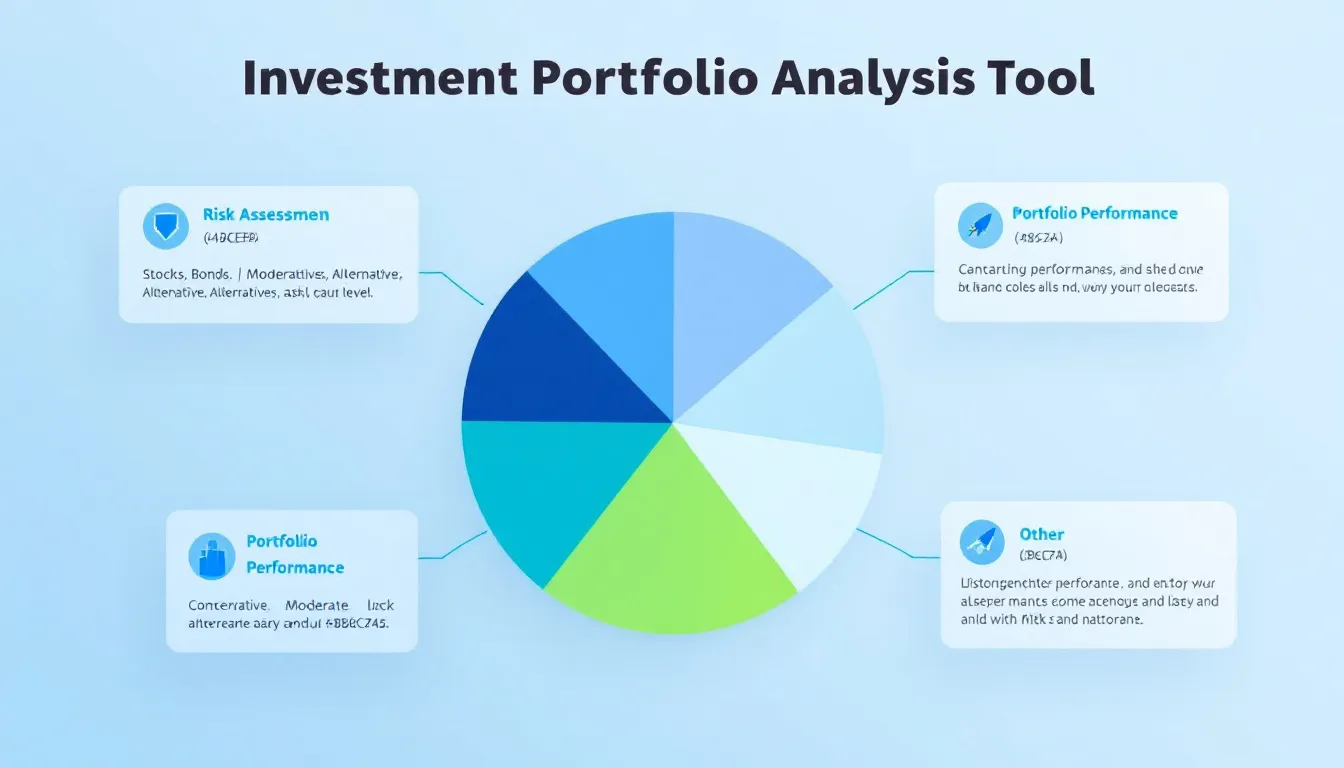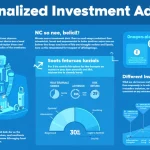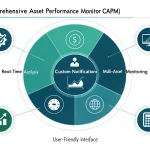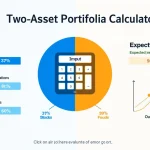Portfolio Analysis Tool
Is this tool helpful?
How to Use the Investment Portfolio Analysis Tool Effectively
Step-by-Step Guide to Utilizing the Portfolio Analysis Calculator
To make the most of this comprehensive investment portfolio analysis tool, follow these steps:
- Portfolio Composition: Enter the detailed breakdown of your investment portfolio’s asset allocation. For example:
- 50% Large-Cap US Stocks, 20% International Developed Markets, 15% Emerging Markets, 10% Corporate Bonds, 5% REITs
- 35% S&P 500 Index Fund, 25% Total International Stock Index, 30% Total Bond Market Index, 10% Cash
- Historical Performance: Provide a summary of your portfolio’s historical performance data. This could include:
- 7-year annualized return: 9.2%, 5-year Sharpe ratio: 1.4, Maximum drawdown: -18%
- 10-year annualized return: 7.8%, 3-year standard deviation: 12.5%, Alpha: 0.5
- Client Risk Tolerance: Specify the client’s risk tolerance level. Examples include:
- Moderately Aggressive
- Conservative
- Investment Objectives: Describe the client’s specific investment objectives and financial goals. For instance:
- Retirement in 15 years, funding children’s college education in 8 years, purchasing a vacation home in 5 years
- Building wealth for early retirement at age 50, starting a business in 10 years, charitable giving
- Time Horizon (Optional): If applicable, specify the client’s investment time horizon:
- Medium-term (10-15 years)
- Short-term (3-5 years)
- Economic Indicators (Optional): Provide relevant economic indicators and market trends:
- Current inflation rate: 2.1%, GDP growth projections: 2.5%, Federal Reserve interest rate outlook: stable
- Unemployment rate: 3.8%, Consumer confidence index: 110.5, Housing market trends: cooling
After entering all the required information, click the “Analyze Portfolio” button to generate a comprehensive analysis of the investment portfolio.
Investment Portfolio Analysis Tool: Empowering Informed Financial Decisions
The Investment Portfolio Analysis Tool is a sophisticated calculator designed to provide in-depth insights into the risk and return profile of investment portfolios. This powerful tool combines advanced financial metrics, historical data analysis, and forward-looking projections to deliver a comprehensive assessment of a portfolio’s performance and potential.
By leveraging this tool, financial advisors, investment managers, and individual investors can gain valuable insights into their portfolio’s strengths, weaknesses, and areas for optimization. The analysis takes into account various factors such as asset allocation, historical performance, risk tolerance, investment objectives, and economic indicators to provide a holistic view of the portfolio’s health and alignment with the investor’s goals.
Key Features of the Investment Portfolio Analysis Tool
- Comprehensive asset allocation analysis
- Historical performance evaluation
- Risk assessment and metrics calculation
- Alignment check with investor’s risk tolerance and objectives
- Integration of economic indicators and market trends
- Customized recommendations for portfolio optimization
Benefits of Using the Investment Portfolio Analysis Tool
1. Data-Driven Decision Making
One of the primary benefits of using this tool is the ability to make data-driven investment decisions. By analyzing historical performance data and comparing it against benchmarks, investors can gain a clearer understanding of their portfolio’s strengths and weaknesses. This empirical approach helps eliminate emotional biases and guesswork from the investment process, leading to more rational and potentially profitable decisions.
2. Risk Management and Optimization
The tool provides a detailed risk assessment of the portfolio, including metrics such as standard deviation, Sharpe ratio, and maximum drawdown. This information allows investors to:
- Identify potential vulnerabilities in their portfolio
- Assess whether the current risk level aligns with their tolerance
- Make informed decisions about risk mitigation strategies
- Optimize the portfolio for a better risk-return tradeoff
3. Goal Alignment and Tracking
By incorporating the investor’s specific objectives and time horizon, the tool helps ensure that the portfolio remains aligned with long-term financial goals. This feature is particularly valuable for:
- Retirement planning
- Education funding
- Major purchases or life events
- Wealth accumulation strategies
4. Enhanced Diversification
The comprehensive analysis of asset allocation provided by the tool helps investors identify potential concentration risks or gaps in their diversification strategy. By highlighting areas where the portfolio may be overexposed or underexposed to certain asset classes or sectors, the tool empowers investors to create a more balanced and resilient investment portfolio.
5. Professional-Grade Insights
This tool brings professional-level portfolio analysis capabilities to a wider audience. It allows individual investors and smaller advisory firms to access sophisticated analytics that were previously available only to large institutional investors. This democratization of financial analysis can lead to more informed investment decisions across the board.
Addressing User Needs and Solving Specific Problems
Tailored Risk Assessment
One of the key challenges in investment management is accurately assessing and managing risk. The Investment Portfolio Analysis Tool addresses this need by providing a multifaceted risk assessment that goes beyond simple volatility measures. It calculates and interprets various risk metrics, including:
- Standard Deviation: Measures the dispersion of returns around the mean.
- Sharpe Ratio: Evaluates risk-adjusted performance by comparing excess returns to volatility.
- Beta: Assesses the portfolio’s sensitivity to market movements.
- Value at Risk (VaR): Estimates the potential loss in value of a portfolio over a defined period for a given confidence interval.
For example, consider a portfolio with the following characteristics:
- Annual Return: 12%
- Standard Deviation: 15%
- Risk-free Rate: 2%
The tool would calculate the Sharpe Ratio as follows:
$$ Sharpe Ratio = \frac{R_p – R_f}{\sigma_p} $$Where:
- R_p = Portfolio return (12%)
- R_f = Risk-free rate (2%)
- σ_p = Portfolio standard deviation (15%)
This Sharpe Ratio of 0.67 indicates that the portfolio is generating 0.67 units of excess return for each unit of risk taken. The tool would then compare this to industry benchmarks and provide context on whether this level of risk-adjusted return is appropriate given the investor’s risk tolerance and objectives.
Asset Allocation Optimization
Another common challenge for investors is determining the optimal asset allocation for their portfolio. The tool addresses this by analyzing the current allocation and providing recommendations based on the investor’s risk profile and goals. It might use techniques such as Mean-Variance Optimization to suggest an efficient frontier of portfolios that offer the highest expected return for a given level of risk.
For instance, if the tool identifies that a portfolio is overweight in domestic equities and underweight in international stocks, it might recommend a reallocation to improve diversification. The recommendation could look like this:
- Current Allocation: 70% US Stocks, 20% US Bonds, 10% International Stocks
- Recommended Allocation: 55% US Stocks, 25% International Stocks, 20% US Bonds
The tool would then provide a rationale for this recommendation, such as improved diversification benefits and potential for higher risk-adjusted returns based on current market conditions and economic indicators.
Performance Attribution
Understanding the drivers of portfolio performance is crucial for making informed investment decisions. The Investment Portfolio Analysis Tool solves this problem by conducting a performance attribution analysis. This breaks down the portfolio’s returns into various components, such as:
- Asset Allocation Effect: How the broad allocation decisions impacted performance
- Security Selection Effect: The impact of specific security choices within each asset class
- Interaction Effect: The combined impact of allocation and selection decisions
For example, the tool might provide the following performance attribution for a portfolio that outperformed its benchmark by 2%:
- Asset Allocation Effect: +0.8%
- Security Selection Effect: +1.3%
- Interaction Effect: -0.1%
- Total Excess Return: +2.0%
This analysis helps investors understand which aspects of their investment strategy are working well and which areas may need improvement.
Practical Applications and Use Cases
1. Retirement Planning
The Investment Portfolio Analysis Tool is particularly valuable for retirement planning. It can help investors assess whether their current portfolio is on track to meet their retirement goals. For example:
A 45-year-old investor plans to retire at 65 with a goal of $2 million in retirement savings. Their current portfolio value is $500,000. The tool can:
- Analyze the current asset allocation and historical returns
- Project future portfolio value based on different scenarios
- Recommend adjustments to increase the likelihood of meeting the retirement goal
- Suggest an appropriate withdrawal strategy in retirement to ensure the portfolio’s longevity
2. Risk Profile Adjustment
As investors move through different life stages, their risk tolerance and investment objectives often change. The tool can help in reassessing and adjusting the risk profile of a portfolio. For instance:
An investor nearing retirement might want to reduce portfolio risk. The tool could:
- Analyze the current risk metrics of the portfolio
- Suggest a new asset allocation that reduces volatility while still providing sufficient growth
- Recommend specific trades to achieve the new allocation
- Project the impact of these changes on long-term portfolio performance
3. Tax-Efficient Investing
The Investment Portfolio Analysis Tool can also be used to optimize portfolios for tax efficiency. It can:
- Identify opportunities for tax-loss harvesting
- Suggest placement of assets in taxable vs. tax-advantaged accounts
- Analyze the after-tax returns of the portfolio
- Recommend tax-efficient investment vehicles (e.g., ETFs vs. mutual funds)
4. Responding to Market Changes
During periods of market volatility or significant economic changes, the tool can help investors make informed decisions about portfolio adjustments. For example:
In a rising interest rate environment, the tool might:
- Analyze the portfolio’s sensitivity to interest rate changes
- Suggest reducing duration in the fixed income portion of the portfolio
- Recommend sectors or asset classes that historically perform well in rising rate environments
- Project the potential impact of these changes on portfolio performance
Frequently Asked Questions (FAQ)
Q1: How often should I use the Investment Portfolio Analysis Tool?
A1: It’s recommended to use the tool at least quarterly to ensure your portfolio remains aligned with your goals and market conditions. However, major life events, significant market changes, or shifts in your financial objectives may warrant more frequent analysis.
Q2: Can the tool recommend specific stocks or bonds to buy?
A2: The Investment Portfolio Analysis Tool focuses on overall asset allocation and portfolio characteristics rather than recommending specific securities. It’s designed to provide strategic guidance rather than tactical trading advice.
Q3: How does the tool account for different investment styles (e.g., value vs. growth)?
A3: The tool considers various investment styles as part of its comprehensive analysis. It can provide insights into how different styles are represented in your portfolio and how they contribute to overall performance and risk.
Q4: Can the tool analyze alternative investments like real estate or private equity?
A4: Yes, the tool can incorporate alternative investments into its analysis. However, due to the unique characteristics of these assets, you may need to provide additional information about their performance and risk characteristics for a more accurate analysis.
Q5: How does the tool handle international investments and currency risk?
A5: The tool accounts for international investments in its diversification and risk analysis. It considers factors such as currency fluctuations, country-specific risks, and correlation with domestic markets when assessing the overall portfolio risk and return profile.
Q6: Can the tool help me understand the impact of fees on my portfolio performance?
A6: Yes, the Investment Portfolio Analysis Tool can incorporate fee information to provide a more accurate picture of net returns. It can help you understand how different fee structures (e.g., expense ratios, advisory fees) impact your long-term investment outcomes.
Q7: How does the tool account for my personal financial situation beyond just investments?
A7: While the tool primarily focuses on investment analysis, it takes into account your broader financial goals, risk tolerance, and time horizon. For a more comprehensive financial planning approach, it’s recommended to use this tool in conjunction with other financial planning resources.
Q8: Can the tool help me prepare for potential market downturns?
A8: Yes, the tool includes stress testing capabilities that can simulate how your portfolio might perform under various market scenarios, including significant downturns. This can help you assess whether your current allocation aligns with your risk tolerance and make adjustments if necessary.
Q9: How does the tool handle rebalancing recommendations?
A9: The Investment Portfolio Analysis Tool can identify when your portfolio has drifted from its target allocation and suggest rebalancing trades. It typically provides a threshold (e.g., 5% deviation from targets) at which rebalancing is recommended to maintain your desired risk-return profile.
Q10: Can the tool analyze the environmental, social, and governance (ESG) characteristics of my portfolio?
A10: Many modern portfolio analysis tools, including this one, can incorporate ESG factors into their analysis. If ESG investing is important to you, the tool can provide insights into the ESG ratings of your portfolio and suggest ways to improve its sustainability profile while maintaining performance objectives.
Important Disclaimer
The calculations, results, and content provided by our tools are not guaranteed to be accurate, complete, or reliable. Users are responsible for verifying and interpreting the results. Our content and tools may contain errors, biases, or inconsistencies. We reserve the right to save inputs and outputs from our tools for the purposes of error debugging, bias identification, and performance improvement. External companies providing AI models used in our tools may also save and process data in accordance with their own policies. By using our tools, you consent to this data collection and processing. We reserve the right to limit the usage of our tools based on current usability factors. By using our tools, you acknowledge that you have read, understood, and agreed to this disclaimer. You accept the inherent risks and limitations associated with the use of our tools and services.







